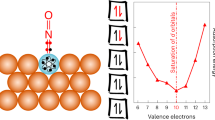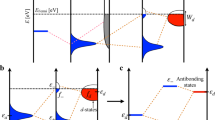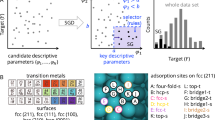Abstract
The immense phase space of multimetallic materials spanned by structural and compositional degrees of freedom precludes thorough screening for efficient alloy catalysts, even with combinatorial high-throughput experiments or quantum-chemical calculations. Based on X-ray absorption spectroscopy measurements and density functional theory calculations, we have identified critical electronic structure descriptors that govern local chemical reactivity of different sites in metal alloys. These descriptors were used to develop a model that allows us to predict variations in the adsorption energy of various adsorbates on alloy surfaces based on easily accessible physical characteristics of the constituent elements in alloys, mainly their electronegativity, atomic radius, and the spatial extent of valence orbitals. We show that this model, which is grounded on validated theories of chemisorption on metal surfaces, can be used to rapidly screen through a large phase space of alloy catalysts and identify optimal alloys for targeted catalytic transformations. We underline the potential of the electronic structure engineering, relating alloy geometry to its catalytic performance using simple electronic structure descriptors, in catalysis.












Similar content being viewed by others
References
Nikolla E, Holewinski A, Schwank J, Linic S (2006) J Am Chem Soc 128:11354–11355
Linic S, Jankowiak J, Barteau MA (2004) J Catal 224:489–493
Yano H, Kataoka M, Yamashita H, Uchida H, Watanabe M (2007) Langmuir 23:6438–6445
Besenbacher F, Chorkendorff I, Clausen BS, Hammer B, Molenbroek AM, Nørskov JK, Stensgaard I (1998) Science 279:1913–1915
Stamenković VR, Fowler B, Mun BS, Wang G, Ross PN, Lucas CA, Marković NM (2007). Science 315:493–497
Guo J, Xie C, Lee K, Guo N, Miller JT, Janik MJ, Song C (2011) ACS Catal 1:574–582
Kitchin JR, Nørskov JK, Barteau MA, Chen JG (2004) J Chem Phys 120:10240–10246
Kitchin JR, Nørskov JK, Barteau MA, Chen JG (2004) Phys Rev Lett 93:156801
Zhang J, Vukmirovic MB, Sasaki K, Nilekar AU, Mavrikakis M, Adzic RR (2005) J Am Chem Soc 127:12480–12481
Xin H, Schweitzer N, Nikolla E, Linic S (2010) J Chem Phys 132:111101–111101
Hammer B (2006) Top Catal 37:3–16
Hammer B, Nørskov JK (1995) Surf Sci 343:211–220
Hammer B, Morikawa Y, Nørskov JK (1996) Phys Rev Lett 76:2141
Nørskov JK, Bligaard T, Logadottir A, Bahn S, Hansen LB, Bollinger M, Bengaard H, Hammer B, Sljivancanin Z, Mavrikakis M, Xu Y, Dahl S, Jacobsen CJH (2002) J Catal 209:275–278
Hammer B, Nørskov JK (1995) Nature 376:238–240
Lambert RM, Pacchioni (1997) Chemisorption and reactivity on supported clusters and thin films. Springer, Berlin
Walter A (1989) Electronic structure and the properties of solids: the physics of the chemical bond. Dover, New York
Schweitzer N, Xin H, Nikolla E, Miller JT, Linic S (2010) Top Catal 53:348–356
Nikolla E, Schwank J, Linic S (2009) J Am Chem Soc 131:2747–2754
Durussel P, Massara R, Feschotte P (1994) J Alloy Compd 215:175–179
Linde JO (1937) Ann Phys 422:151–164
Mansour AN, Cook JW, Sayers DE (1984) J Phys Chem 88:2330–2334
Rehr JJ, Ankudinov AL (2005) Coord Chem Rev 249:131–140
Ankudinov AL, Nesvizhskii AI, Rehr JJ (2001) J Synchrotron Radiat 8:92–95
Muller DA, Singh DJ, Silcox J (1998) Phys Rev B 57:8181
Rez P, Muller DA (2008). Annu Rev Mater Res 38:535–558
Keast VJ, Scott AJ, Brydson R, Williams DB, Bruley J (2001) J Microsc 203:135–175
Iwasawa Y (1996) X-ray absorption fine structure for catalysts and surfaces. World Scientific, River Edge
Ankudinov AL, Rehr JJ, Low JJ, Bare SR (2001) J Synchrotron Rad 8:578–580
Nesvizhskii AI, Rehr JJ (1999) J Synchrotron Rad 6:315–316
Lei Y, Jelic J, Nitsche LC, Meyer R, Miller J (2011) Top Catal 54:5–7
Prado RJ, Flank AM (2005) Physica Scripta 115:165
Lie K, Brydson R, Davock H (1999) Phys Rev B 59:5361–5367
Gao S, Pickard CJ, Perlov A, Milman V (2009) J Phys 21:104203
Müller JE, Wilkins JW (1984) Phys Rev B 29:4331–4348
İnoğlu N, Kitchin JR (2011) ACS Catal 1:399–407
Xin H, Holewinski A, Linic S (2011) ACS Catal 2:12–16
İnoğlu N, Kitchin JR (2010) Mol Simul 36:633
Denton AR, Ashcroft NW (1991) Phys Rev A 43:3161–3164
Xin H, Linic S (2010) J Chem Phys 132:221101–221101
Nørskov JK (1989) J Chem Phys 90:7461–7471
Abild-Pedersen F, Greeley J, Studt F, Rossmeisl J, Munter TR, Moses PG, Skulason E, Bligaard T, Nørskov JK (2007) Phys Rev Lett 99:016105-4
Wang JX, Marković NM, Adzic RR (2004) J Phys Chem B 108:4127–4133
Marković NM, Schmidt TJ, Stamenković V, Ross PN (2001) Fuel Cells 1:105–116
Nørskov JK, Rossmeisl J, Logadottir A, Lindqvist L, Kitchin JR, Bligaard T, Jonsson H (2004) J Phys Chem B 108:17886–17892
Bondarenko AS, Stephens IEL, Hansen HA, Pérez-Alonso FJ, Tripkovic V, Johansson TP, Rossmeisl J, Nørskov JK, Chorkendorff IB (2011) Langmuir 27:2058–2066
Stephens IEL, Bondarenko AS, Perez-Alonso FJ, Calle-Vallejo F, Bech L, Johansson TP, Jepsen AK, Frydendal R, Knudsen BP, Rossmeisl J, Chorkendorff IB (2011) J Am Chem Soc 133:5485–5491
Zhang J, Vukmirovic MB, Ye X, Mavrikakis M, Adzic RR (2005) Angew Chem Int Ed 44:2132–2135
Ghosh T, Vukmirovic MB, DiSalvo FJ, Adzic RR (2010) J Am Chem Soc 132:906–907
Stamenković V, Mun BS, Mayrhofer KJ, Ross PN, Marković NM, Rossmeisl J, Greeley J, Nørskov JK (2006) Angew Chem Int Ed 45:2897–2901
Gong K, Dong S, Adzic RR (2010) J Am Chem Soc 132:14364–14366
Xing Y, Cai Y, Vukmirovic MB, Zhou W-P, Karan H, Wang JX, Adzic RR (2010) J Phys Chem Lett 1:3238–3242
Mizutani U (2010) Hume-Rothery rules for structurally complex alloy phases, 1st edn. CRC Press, Boca Raton
Vanderbilt D (1990) Phys Rev B 41:7892
Perdew JP, Chevary JA, Vosko SH, Jackson KA, Pederson MR, Singh DJ, Fiolhais C (1992) Phys Rev B 46:6671
Monkhorst HJ, Pack JD (1976) Phys Rev B 13:5188
Acknowledgments
We gratefully acknowledge the support of the US Department of Energy DOE-BES, Division of Chemical Sciences (FG-02-05ER15686) and the National Science Foundation (CBET 1132777). S. Linic also acknowledges the DuPont Young Professor grant by DuPont Corporation and the Camille Dreyfus Teacher–Scholar Award from the Camille & Henry Dreyfus Foundation.
Author information
Authors and Affiliations
Corresponding author
Appendices
Appendix 1: Experimental Details
The Pt catalysts were synthesized using a dry impregnation method utilizing γ-Al2O3 powder (Alpha Aesar, 3 micron, BET surface area (S.A.) ~78 m2/g, 99.97% metal basis) as a support. To remove impurities from the support, the powder was first stirred in DI water. Ammonium hydroxide was then added to the solution until the pH reached ten. The powder was then rinsed several times with DI water, dried under vacuum overnight, and calcined in air at 500 °C for 3 h. The Pt catalyst (10 wt% Pt with respect to γ-Al2O3 support) was prepared by dissolving the appropriate amount of H2PtCl6·6H2O (99.95 % metals basis; Alpha Aesar) in just enough volume of water to fill the micro pore structure of the γ-Al2O3 support, as measured by BET analysis (0.366 mL/g). The solution was added dropwise to the γ-Al2O3 support. To ensure an even coverage of the solution on the support, the powder was shaken vigorously during the addition of the solution. Following the addition of the solution, the powder was crushed with a mortar and pestle.
To synthesize the alloy catalysts, a similar impregnation procedure was used to deposit an equimolar amount of Pt and the secondary metal on the support. In this case two solutions, one containing H2PtCl6·6H2O (sufficient for a 5 % Pt/Al2O3) in DI water and the other containing an equimolar amount of the secondary metal salt (CuCl2, RuCl3, or SnCl2) in DI water, were prepared. The total amount of DI water between the two solutions was enough to fill the micropore structure of the support. The Pt and secondary metal solutions were then dispersed on the γ-Al2O3 support sequentially, as described above. All samples were then dried overnight under vacuum, and reduced in hydrogen (cryogenic gases, prepurified, 200 mL/min) at 300 °C for 3 h.
X-ray absorption spectroscopy (XAS) measurements were performed at Argonne National Laboratory Advanced Photo Source (APS) beamline MR-CAT 10-ID-B. Scans of the Pt L 3 edge (~11,564 eV) were collected in transmission mode using standard equipment and procedures available on-site. The spectra for each sample were recorded simultaneously with the spectra for Pt foil, containing pure Pt, which was used for energy calibration. Samples were packed into wafers supported in a steel sample tube, which could accommodate six separate samples. The steel sample holder was then placed in a glass in situ reactor. The samples were re-reduced in 4 % H2/N2 at ~600 K for 1 h. To ensure that any residual hydrogen is removed for the catalysts, the samples were flushed in N2 at ~600 K before reducing the temperature of the samples to room temperature. Scans were performed at room temperature in trapped nitrogen.
XAS measurements in the extended edge region (EXAFS) were analyzed using free online software Athena and Artemis, utilizing standard analysis procedures. First, the alloy curves were calibrated by setting the energy of the Pt foil edge data with the maximum slope to the theoretical Pt L 3 edge energy, 11,564 eV. This point is defined as the edge onset energy, E 0. Next, the background signal for each curve was removed by fitting the pre-edge data to a linear function and subtracting out the result. The curves were normalized by fitting the post-edge data to a third degree polynomial and dividing the data by the extrapolated value at E 0. XAFS data was fit using Artemis. Phase and amplitude for each first nearest neighbor scattering path (Pt–Pt and Pt–M where M = Cu or Sn) were calculated using FEFF. The fitting parameters were optimized using a least squares analysis of the nearest neighbor region of the k 1, k 2, and k 3 Fourier transform data.
Appendix 2: Computational Details
The adsorption energies for various adsorbates on the different model systems were calculated with respect to the corresponding gas phase energies (CO, O2, OH and H2) using first-principles density functional theory (DFT) calculations. The DFT calculations were performed using the ultra-soft pseudopotential [54] plane-wave method with the generalized gradient approximation (GGA-PW91) [55] coded in DacapoFootnote 1. The wave-functions were expanded in plane-waves with an energy cutoff of 350 eV. Spin-polarization is not included in our calculations since it did not affect the trend of chemisorption energies of simple adsorbates on Pt and Pt alloys. The surface was modeled by a 2 × 2 × 4 slab separated by 10 Å of vacuum space. We note that the second generation core–shell alloys are modeled by 2 × 2 × 6 slab to accommodate the buffer layers between the Pt monolayer and the inner core structure. An adsorbate was placed on one side of the slab. The impact of the adsorbate-induced dipole moment was minimized by applying a dipole correction. The adsorbates and top two layers were allowed to relax until the total force on the atoms was less than 0.05 eV/Å. In the p(2 × 2) surface unit cell, 4 × 4 × 1 Monkhorst–Pack k-points [56] were used for the Brillouin-zone integration. A finite temperature Fermi function (k B T el = 0.1 eV) was utilized to facilitate the SCF convergence, and the total energy was extrapolated to k B T el = 0 eV. This computational setup allowed for the convergence of relative adsorption energies, with the maximum change in the difference between the adsorption energies of an adsorbate on any two substrates less than 0.02 eV for calculations with increased accuracy. The d-band density of states was determined by the projection of plane-waves onto spherical harmonic orbitals, with the cutoff radius at infinity. The d-band center was calculated as the first moment of the projected d-band density of states on the surface atoms referenced to the Fermi level, and the mean squared d-band width was calculated as the second central moment of projected d-band density of states.
X-ray absorption near edge structure (XANES) of the Pt L 3-edge (oscillator strength) was calculated from first-principles, using plane-wave pseudopotential approach within the CASTEP [34] code, by evaluating the oscillator strength for the electron transition from 2p Pt core states to the Pt 6s and 5d states above the Fermi level. The exchange–correlation was described using PW91 functional of the generalized gradient approximation (GGA). The wave-functions are expanded in plane-waves with an energy cutoff of 400 eV. A (12 × 12 × 12) Monkhorst–Pack set of k-points was used for Brillouin-zone sampling of 1 × 1 × 1 unit cell and the k-points density was kept identical for calculation with different supercell size. In order to compare the calculated oscillator strength with measured XANES spectra, the system was modeled by a supercell with the lattice constant from experimental measurement. To account for the impact of a core hole, generated in the process of the XANES measurement, on the electronic structure the ultrasoft pseudopotential for the atom in the supercell was generated with partial occupancy of core states. All calculations with core–holes were carried out using supercells sufficiently large to eliminate the interactions between core–holes in the periodic images. Our calculations, in agreement with previous literature, have indicated that 8 Å is large enough to isolate the interaction between images. The calculated spectra for all alloys are adjusted (shifted in energy by a constant value) so that the calculated edge onset energy for pure Pt corresponds to the experimentally measured edge onset energy of pure Pt L 3-edge. Gaussian broadening with 3.0 eV, which encompasses instrumental broadening and the lifetime of excited states, was applied in order to compare calculated spectra to experimental measurements.
Appendix 3: Parameters
Rights and permissions
About this article
Cite this article
Xin, H., Holewinski, A., Schweitzer, N. et al. Electronic Structure Engineering in Heterogeneous Catalysis: Identifying Novel Alloy Catalysts Based on Rapid Screening for Materials with Desired Electronic Properties. Top Catal 55, 376–390 (2012). https://doi.org/10.1007/s11244-012-9794-2
Published:
Issue Date:
DOI: https://doi.org/10.1007/s11244-012-9794-2




